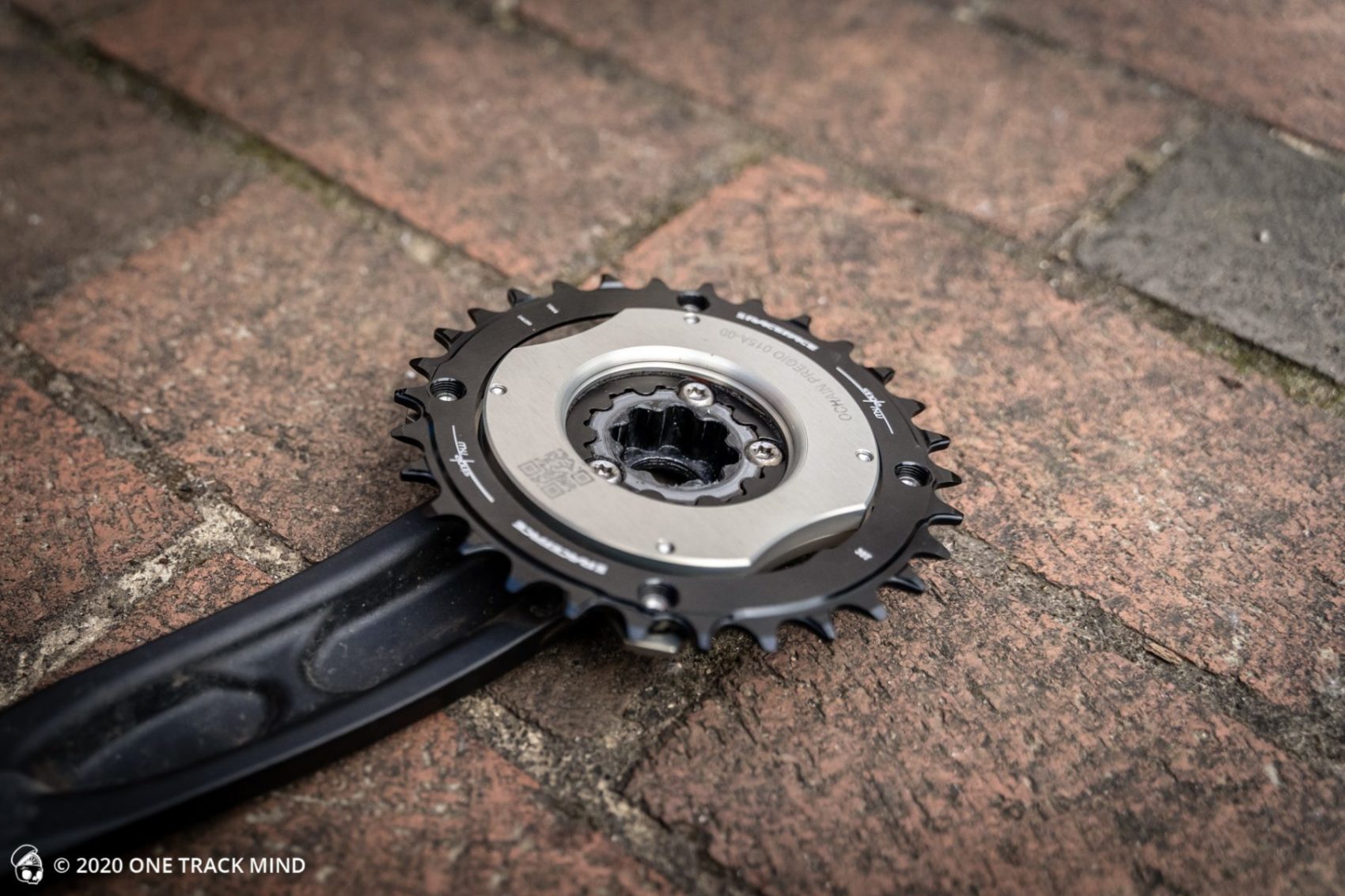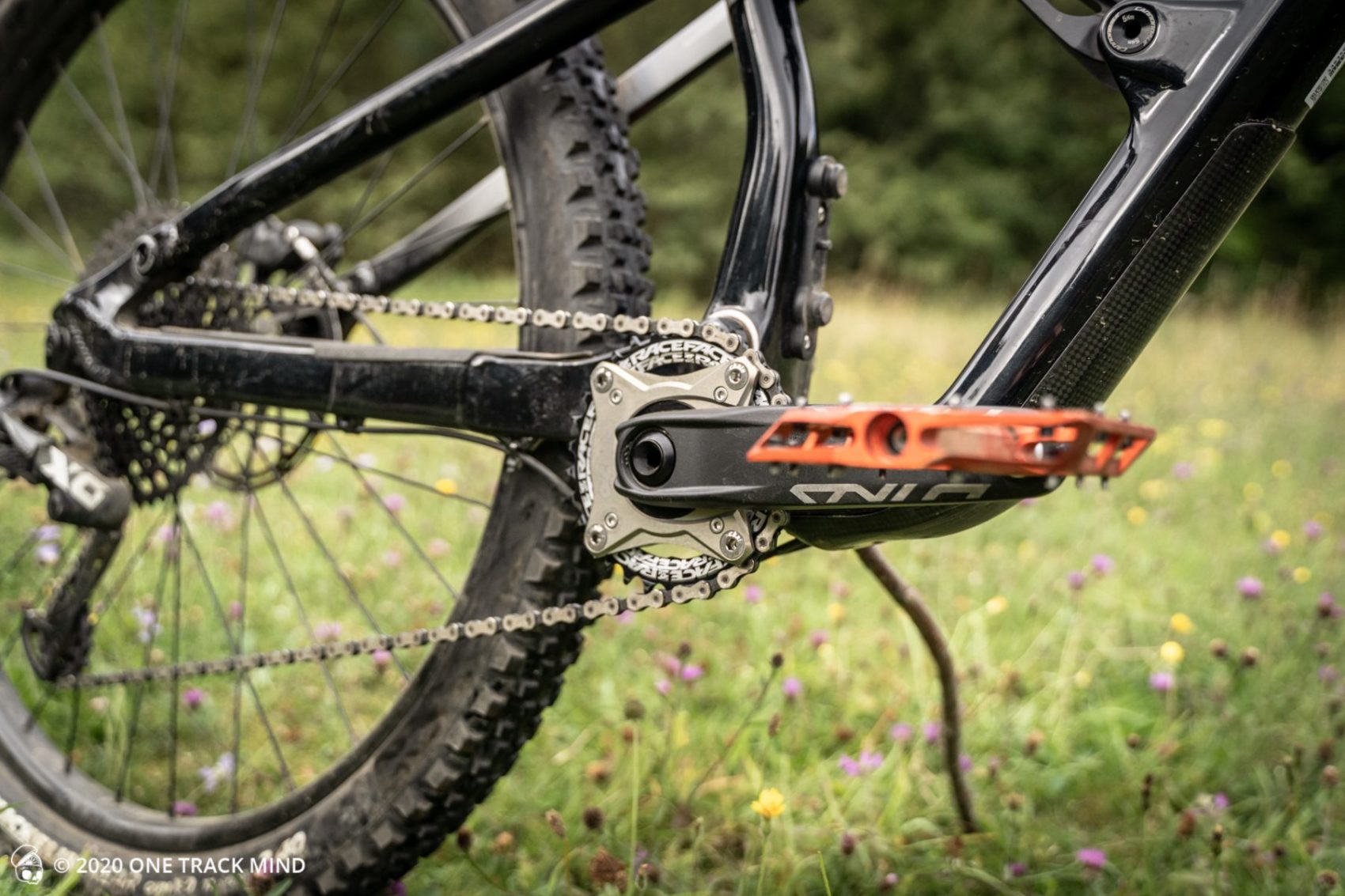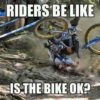Ochain Active Spider Review – Does it really give you that chainless feeling?
Ochain is a new company that has recently released their Ochain Active Spider priced at £279.99 (Standard) through UK Distributor Cyclorise and €349.00 (Pregio which is the version we tested currently not available for purchase through Cyclorise). The device claims to reduce pedal kickback providing you with a chainless feeling with improved suspension and braking performance. Will at One Track Mind Cycling Magazine was tasked with testing the product to see if it lives up to these claims.

What is the Ochain Active Spider?
The Ochain Active Spider essentially replaces the crank spider but unlike a traditional spider which is a fixed this product allows for 6-12° of tunable rearward rotation between the chainring and cranks. This small amount of give allows the chain to move backwards without taking the cranks with it reducing pedal kickback which in turn allows suspension and braking to perform better and make for a smoother ride in generals.
The Ochain is currently only available for Hope, Shimano, E*Thirteen, RaceFace and SRAM cranksets currently. To use the Active Spider you will also need to have a chainring with a standard 104mm BCD. You can order a Pilo chainring directly through Cyclorise if you buy direct from them.

How does the Ochain work?
The Ochain is made up of two core plates that rotate against each other. Taking the product apart we saw that it consisted of three springs that keep the plates apart when not pedalling and Elastomers that dampen in both directions reducing wear and tear, noise and softening engagement.

These Elastomers can be swapped out for different sizes so that you can tune the amount of rotational movement to your desired preference. When pedalling 4 metal teeth engage which in turn connect the chainring to the cranks. This allows you to pedal normally with only a small amount of pedal dead zone.

So what exactly is pedal kickback?
We hear about pedal-kickback a lot these days, but what exactly is it? Well, essentially pedal kick means the result of chain growth rotating the cranks backwards during suspension compress. The effect is a byproduct of anti-squat which is a characteristic of suspension on mountain bikes. Anti Squat is a term for suspension engineers to determine how much the suspension mechanism itself is resisting suspension compression. When your bike suspension compresses the chain top part of the chain needs to grow which in many mountain bike suspension designs results in the cranks being pulled backwards. This is Pedal Kickback.
If you have ever snapped your chain and continued to ride down a trail you will have noticed the lack of Pedal Kickback and most likely noticed that your suspension has never felt better. The ride is smoother, you are able to brake more efficiently. Personally, I’ve had some of my best race runs with a snapped chain and we all know about the time Aaron Gwin won a World Cup Downhill round with a snapped chain.
The Ochain want to offer that same feeling and performance improvements without the negatives of not being able to pedal due to the lack of a chain.

How does Ochain reduce pedal kickback?
Using the small amount of rotational give (6-12 degrees depending on how you’ve tuned the Ochain) the chain and chainring is able to move independently from the cranks reducing the effects of kickback.


Does the Ochain negatively affect pedalling performance?
Yes and no. The Ochain does have an initial impact on pedalling performance as you put force through the pedal the Ochain rotates until the teeth engage allowing you to pedal normally. There is a noticeable dead spot whilst the Ochain Active Spider is rotating which feels very similar to that of using a low engagement hub. However, once the teeth have engaged pedalling feels normal and as long as you keep the teeth engaged whilst pedalling you won’t notice the dead spot again.
You may be thinking “why would I spend a load of money on a product that essentially makes it feel like I’m using a cheap low engagement hub?”. Well, this is where you need to weigh up the pros and cons of the product. Do the benefits of chainless feeling with no pedal kickback outweigh the negatives of an initial dead spot when pedalling? This is a personal preference and maybe lends more to your style of riding. If you are all about pedalling, keeping you cadence up and riding XC then maybe this isn’t the product for you but if you are smashing downhill on an enduro or downhill bike then the benefits of no pedal-kickback will soon pay off.

Can I custom tune the Ochain?
The Ochain comes with different sizes elastomers allowing you to fine-tune the product. You can choose between 6-12° of rotational movement. The higher the rotational movement the more pronounced the pedal dead spot will be but the less pedal kickback you will receive.
Although fiddly to tune the Ochain it’s quite easy. Just undo the allen bolts and carefully pull the two plates apart being careful not to lose any of the springs, ball bearings and elastomers held inside. Change the elastomers to your desired choice and realign the plates and tighter the allen bolts back to correct torque. I found this quite fiddly to line up all the loose components especially with the grease used to keep the Ochain lubricated. Take your time when doing this and make sure you do not lose anything which is easy to do.

Ochain Active Spider review. Does it work?
The Ochain certainly works as described. Whilst riding with the Ochain Active Spider fitted for a few weeks I rode as many rocky and rooty trails as I could. I fitted the device to a Cannondale Jekyll 2 2020 and also took an identical bike with me to compare. The differences in pedal kickback were very noticeable with the Ochain bike feeling smoother and therefore faster through the trails. I also felt less fatigued at the end of the trail which I put down to the smoother ride and my body not having to fight the bike over rough sections.
During the Ochain review, we had a bike test come through, the Deviate Highlander. This bike had a high idler which is another solution to reduce pedal-kickback and anti-squat. I won’t go into the details of this bike test here as this will be out soon in a later article but comparing the two solutions revealed some interesting results. Both solutions noticeably reduced pedal-kickback but performed very different due to the suspension design. This was really apparent as both bikes suspension were able to perform really well due to the lack of pedal-kickback. The Cannondale felt smoother but the high pivot bike had an added bonus of the rear wheel moving backwards through its suspension travel which felt like it was pushing the bike forwards gaining speed whilst riding through rough terrain.
The negatives of high pivot bikes are the added complexity in the system and the requirement for an extra-long chain which isn’t required for the Ochain. The benefits of the Ochain is that it can be introduced into a non-high pivot design but does introduce a small amount of dead spot in the pedal stroke which the high-pivot bike doesn’t have.
Summary
So, in summary, the Ochain Active Spider does live up to the claims of the manufacturer. It does reduce pedal kickback improving performance of both suspension and braking, makes for a smoother ride but does introduce added complexity to your bike.
The product isn’t cheap and it does introduce an initial dead spot to the pedal stroke which after a few rides you barely notice and usually you only notice it on the initial pedal stroke and is not a constant issue.
Weighing up the pros and cons of the Ochain Active Spider is perhaps a personal preference and maybe more down to the type of riding you take part in most. The main benefits from the system come from descending rough terrain and its main negatives come from pedalling and ascending so I would suggest this device is better suited to Downhill and Enduro styles of riding.
What do you think of the Ochain Active Spider? Would you be interested to try it on your bike? Do you think the pros outweigh the cons? Have you seen some other solutions to the pedal kickback problem?
Let us know your thoughts and opinions in the comments section below.




























I was dissappointed to find that the unit fouls on my Hope evo cranks when using the 9 degree setup. Hopefully 6 deg is okay, 12 deg is obviously not an option. Perhaps I’ll get the full 9 deg once it sufficiently worn through. Quite a poor design process if a clash like that was never considered or noticed. I’d expect better from a £300 chainring.